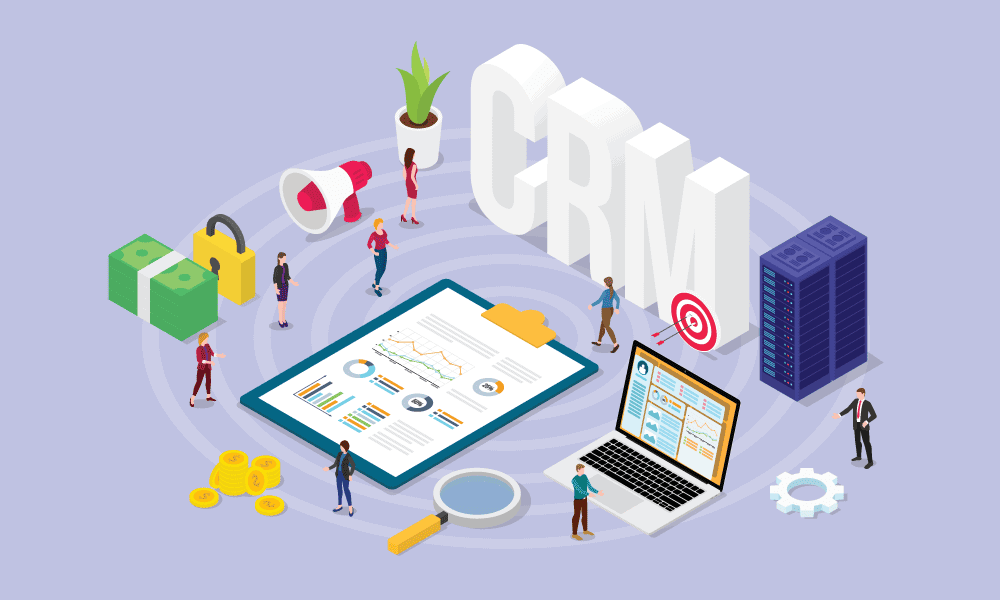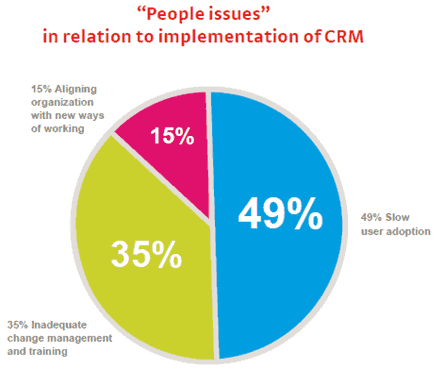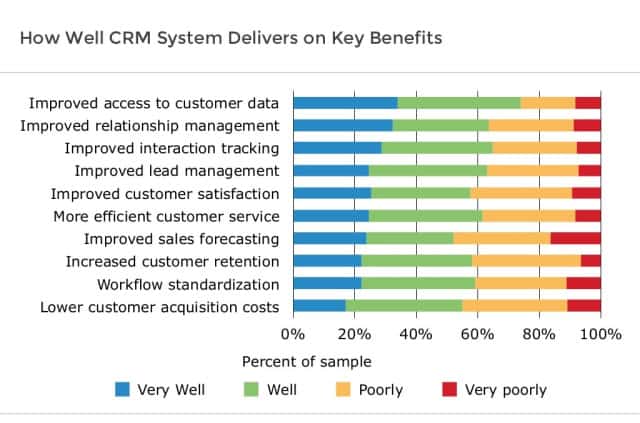Most organizations today rely on a sophisticated Customer Relationship Management (CRM) solution to structure their orders and revenue.
CRMs provide a high level of efficiency and an organized flow to your business. If you are already thinking about whether or not should you for CRM solutions, the answer is a “Yes”!
CRMs allow you to keep the consumer data safe and clutter-free. They help you eliminate the manual methods of data entry, which aren’t only time consuming but also prone to mistakes. Moreover, an efficient CRM adapts to your needs and serves the duties of a project manager too.
However, a great deal depends on the pace of its adoption in your organization. This can be done before implementing a CRM.
Adopting SaaS CRM the right way definitely benefits your enterprise in more ways than one, including delivering superior customer service, no doubt about that. However, more often than not, people get the process wrong and hence, the debacles!
Look at this important statistic from Merkle Group, Inc. which says that companies that are successful in CRM adoption saw clear benefits and real business value.
The same survey says that the failure rate of CRM adoption in large companies is nearly 63%. Clearly, this is an unacceptable number and companies need to follow the right strategies around CRM end-user adoption.
Table of Contents
But what does end-user CRM adoption really mean for enterprises?
Very often companies need a new tool, software, an automaton, etc. to fulfill a specific task. This task could be a revamped one or an altogether new one.
The old software may not be geared to fulfill this specific task and therefore, a need arises for a new tool. However, there could be various people who would be using this new tool or automaton.
Some of them may already be well-acquainted with the features of the new tool, while others may need a bit of an induction into the software.
These people would be working on this new tool as if they are working on a car assembly chain- each one adding value to the final product. In this value chain, the person who works on this tool directly is the end-user. Thus, it is important that your team has no problems getting acquainted with the software.
Thus, whichever CRM vendor you choose to go for, it is important that the product has a high software user adoption rate.
The challenge before small, medium and large companies are to spur the end-user adoption. The man or woman who is working on this tool directly is the key to end-user adoption. Unless he/ she embraces the new tool wholeheartedly, the CRM adoption process would be a wasted exercise.
Slow or negligible end-user CRM adoption means more inefficiency in the entire business process. Profits might erode and in the long term, enterprises might turn unviable.
Obviously, the next question is how to drive end-user adoption.
Driving end-user CRM adoption- best strategies
- 1. Convey benefits
- 2. Co-opt users
- 3. Advocating your CRM implementation
- 4. Practice, practice, practice
- 5. Plug holes
- 6. Drilling down the process
- 7. Getting the right training
- 8. Personalize and simplify your CRM
- 9. Mobile and social tools friendly
- 10. Make CRM adoption fun
- 11. Make your CRM scalable and flexible
- 12. Make your CRM the only repository
While formulating efficient CRM strategies, the end-user needs to be the main criteria in consideration. In fact, the best CRM user strategies start with keeping the needs and skill set of the end-user in mind.
After all, it is he who needs to be convinced about the positives of CRM adoption. The benefits of CRM usage should be driven home.
So how can we drive CRM implementation?
Following are a few pointers that could help you achieve that:
1. Convey benefits
Your enthusiasm for your new CRM tool may not be shared by its users. Perhaps they feel that the new tool has been installed to drive up profits while laying off some of the workforce.
At the core of any product should be the good old “What’s in it for the user?”
Perhaps it would be great to tell your employees how the new CRM adoption program will drive their productivity. Companies need to link CRM adoption to personal growth and development.
2. Co-opt users
The success or failure of any project depends upon whether your vision is shared by your employees. Your end-users need to have a voice in your CRM implementation process.
Make them key stakeholders while rolling out your user adoption strategies. Encourage their participation.
An efficient employer would make it a point to take their feedback on the existing CRM. Observe their pain points, and try removing all the potential bottlenecks well before your new CRM is in place.
3. Advocating your CRM implementation
Since you are introducing a new tool, you are likely to run into significant opposition from your users. Perhaps these people have been using the existing software for several years and are accustomed to it.
Any new change in their work habits will draw out loud moans and protests.
A great way to handle this stress is to hire advocates for your CRM implementation strategy. These champions will be the sieves through which your CRM adoption program strategy will flow. You may also consider easing this transition by setting up a guide or human assistance for the purpose.
4. Practice, practice, practice
The best way to improve CRM user adoption rate in your organization is to encourage everyone in your CRM chain to practice the new tool regularly. Even though this advice is more behavioral than technical, this doesn’t take away its significance.
Just 40% of all the enterprises have a 90% user adoption rate and this statistic has to do with regular use of their newly launched CRM products.
5. Plug holes
If you are in the business of selling a product or service, you must integrate your lead capture process with your CRM tool. Many companies miss out on this last mile connectivity and lose vital leads in the process.
Plug this hole immediately while rolling out your CRM adoption program.
Many customer relationship management programs come with APIs that make lead capture a smooth process. Drive-up your business profitability by following this strategy.
Several marketing organizations collect their leads manually and then add them to their CRM tool manually again. The end-user who actually does this task doesn’t feel enthused by this process. Moreover, add to that the constant probability of human errors!
When you integrate your lead capture process with your CRM software, you are essentially empowering your end-user, which will eventually drive up your adoption rate.
6. Drilling down the process
If your CRM system is geared around sales and marketing you need to pay close attention to this advice.
Ensure that all your salespeople follow the same CRM process to the T, else your CRM adoption strategy would be messed up big time. You will have to drill down this process within your sales team, no questions asked.
When you follow this strategy, your entire process will be documented. In case one of your executives leaves your organization, the new hire can quickly pick up this process.
7. Getting the right training
An added challenge to your CRM adoption strategy is controlling your training costs. Plus you also need to figure out the right training program for your users.
Having champions in your CRM implementation team definitely helps. You only need to train these ‘evangelists’ who will later-on coach the rest of the team during its CRM adoption journey. Alternatively, you can also go for a Certified SugarCRM Partner who can help you in your CRM adoption by customizing your system to your business needs.
8. Personalize and simplify your CRM
You don’t need to use your new CRM tool the same way it has been used by other enterprises. Since your business is unique, so should be your customer relationship management tool.
And who doesn’t like a healthy dose of personalization at work?
Personalize this tool by creating fields, titles, and workflows, etc that are in sync with your business processes. Relevancy should be the watchword while rolling down your CRM adoption program.
Secondly, make your CRM tool as simple as possible. Keep the end-user and his work environment in mind.
Remember, this tool is meant for your last mile user. Don’t complicate your tool with features that confuse him.
9. Mobile and social tools friendly
As our workforce becomes increasingly mobile, it makes sense to develop those business processes that are in sync with this new human behavior.
Mobile CRM user adoption can be speeded up by making your CRM processes mobile and smartphone friendly. Empower your end-user by letting him operate his tool remotely with the help of his mobile device, laptop or smartphone.
Similarly, you can incorporate some of the modern social tools like the ‘Follow’, ‘Like’ buttons to make your CRM adoption program interesting and effective.
Many modern businesses have found this approach quite interesting when it comes to bringing a positive effect on the end-users. Sales opportunities can be shared among team members and business alerts can be set whenever something new is coming up.
Through Social CRM, modern businesses can convert their social networks into valuable lead listening and capture funnels.
10. Make CRM adoption fun
There is nothing better than having a clean and healthy competition in the workplace. And business owners can drive up their adoption rates by organizing regular competitions within their companies.
For instance, you can identify the top performers in your outbound call process (who used this new tool) and reward them for their performance. Similarly, you can incentivize your other employees working in departments using your CRM tool.
Make this competition a regular affair and announce the names of the winners; you’d be surprised at the positive resonance it creates in your company.
Create happy sales reps!
11. Make your CRM scalable and flexible
As your business evolves, your customer relationship tool should also change, and grow in size.
Does your current product have that kind of scalability and flexibility? If it has, it means your user adoption rates will remain high in the future, all things considered.
In short, make your CRM future-proof.
12. Make your CRM the only repository
If your team members still hold back their critical customer data and don’t put in your CRM database, then it would be a bad investment.
Convince your team that the new CRM tool has all the features they need. Tell them that this new tool is the only thing that they are going to use for a long time.
Image Courtesy: Super Office
Building a robust CRM strategy
- 1. The outcome of business strategy
- 2. Mapping your customer journey
- 3. Organizational touchpoints
- 4. Setting goals
- 5. Installing the CRM processes and components
- 6. Setting the right CRM software
There are several CRM strategies, in fact, every business can have its own strategy set, but these are the most commonly accepted ones.
1. The outcome of business strategy
Your CRM strategy should be a subset of your overall business model, goals and strategy. You need to understand your customers, markets, competitors, and partners before you roll out your CRM strategy.
2. Mapping your customer journey
How does your customer find your brand? How does she evaluate it and later buy it?
These are some customer journey questions that should fashion your CRM launch and adoption. This would not only help in rolling out a good CRM strategy but also answer intricate questions your team or you may have on the customer experience of your brand.
3. Organizational touchpoints
Identify all your relevant employees who will have access to your new software. While this is done, you may also identify the accessibility they would have on the new CRM tool.
4. Setting goals
Once you have identified your organizational touchpoints, you need to set up goals for each of your teams. You also need to install a reward mechanism for quicker CRM adoption. Your CRM adoption rate ought to be high.
Those targets should be trackable and achievable.
5. Installing the CRM processes and components
This strategy is more granular and has to do with the nitty-gritty of making this CRM work. You will need to figure out the right workflows, processes, logins, etc in order to make your tool navigable and user-friendly.
6. Setting the right CRM software
Once you have identified your needs, organizational touchpoints and goals, it is time to buy the right software. This stage is quite crucial in your CRM adoption strategy.
Small businesses can expect to pay more than $10 as monthly fees, while the corresponding fees for medium and big businesses would definitely be higher.
Ensure that your new software is future proof and that you can modify and scale it up in the future.
Best practices to mitigate CRM user adoption
- 1. Is your CRM strategy in alignment with your business vision and strategy?
- 2. Do you have a solid plan in place?
- 3. Having the right team
- 4. Beta testing
- 5. Speak to your customer
- 6. Design it for the actual users
- 7. Manage change
- 8. Managing risks
You can mitigate your CRM user adoption by following these simple processes:
1. Is your CRM strategy in alignment with your business vision and strategy?
Experts in this field say that your customer relationship strategy ought to have the following elements:
- Specific
- Measurable
- Actionable
- Result oriented
- Time-bound
2. Do you have a solid plan in place?
A good way to mitigate your CRM user journey is to have several elements tied together. As a business owner, you should know about the various dependencies, constraints, resource points, breakdowns, etc in your CRM plan.
This way, your CRM adoption process will be quicker, smoother and more fruitful.
3. Having the right team
Just having the right strategy and plan is not enough. You also need to have a workable team to execute your CRM rollout plan.
As said earlier, business owners need to have product champions in their teams who work as evangelists.
4. Beta testing
It makes no sense to throw a live product at people who have had no experience running it. If you want to make the user adoption of your CRM smooth and effective, you need to test your new product with a few people.
Identify the glitches, remove them and then roll out your new CRM software.
5. Speak to your customer
Every product has a customer and your new small business CRM platform’s customers are its actual users. Speak to them and find out what they feel about it. After all, customer satisfaction should be one of the primary objectives of implementing CRM and its adoption.
Experience your product through your end users who are going to be using it day in & day out.
6. Design it for the actual users
If you want that the adoption of your CRM platform is frictionless, design it for your actual users. Its design should be simple, and intuitive.
For example, the first screen of your platform should specifically tell all the users what they need to do next. CRM statistics should be easy to read and interpret. Make the system work for you rather than your system making your end-users work for it.
7. Manage change
According to a U.S Department of Labor study, productivity dips by 75% during unmanaged change. So what can you do about it?
As a business owner, you need to manage this transition by ensuring there is minimum downtime while deploying your new software. A crucial element of your user adoption strategies needs to be managing the change.
One way to achieve it is to identify that set of users who are likely to resist this change more than the others. Coach them on how to use this new tool and also tell them how this new system will help them in their professional journey.
8. Managing risks
Can you identify all the possible risks and manage them? It may sound difficult to many business owners but an effective way to mitigate CRM user adoption is to anticipate risks and remove them.
For efficient risk analysis, you would need to know every minute detail of the product. This can be obtained by being involved with the end-user, the customer of your CRM itself.
As is with any product, the key to success is actually being able to provide a solution to a problem, which hasn’t been dealt with yet.
To mitigate any potential problems, design your CRM system in a way that is scalable, measurable, crisp, time-bound and also is relevant. Adopting your CRM the right way will have a cascading effect on your profits.
To sum up, your CRM adoption strategy must resonate with your corporate goals and strategy.






